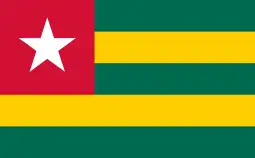The Degtyaryov machine gun (Russian: Пулемёт Дегтярёвa Пехотный, romanized: Pulemyot Degtyaryova Pekhotny literally: "Degtyaryov's infantry machine gun") or DP-27/DP-28 is a light machine gun firing the 7.62×54mmR cartridge that was primarily used by the Soviet Union, with service trials starting in 1927, followed by general deployment in 1928.
Besides being the standard Soviet infantry light machine gun (LMG) during World War II, with various modifications it was used in aircraft as a flexible defensive weapon, and it equipped almost all Soviet tanks in WWII as either a flexible bow machine gun or a co-axial machine gun controlled by the gunner. It was improved in 1943 producing the DPM, but it was replaced in 1946 with the RP-46 which improved on the basic DP design by converting it to use belt feed. The DP machine gun was supplemented in the 1950s by the more modern RPD machine gun and entirely replaced in Soviet service by the general purpose PK machine gun in the 1960s.
Design
The DP-27 is a light machine gun designed for the Soviet Red Army in the 1920s under the leadership of Vasily Degtyaryov (1880–1949), the first test model being the DP-26. Two test guns were manufactured and fired 5,000 rounds each from September 27–29, 1926, during which weaknesses were discovered in the extractor and firing pin mechanisms. After design improvements, two more guns were made and tested in December 1926, firing 40,000 rounds under adverse conditions, resulting in only .6% stoppages. However, changes to the bolt carrier and the chamber locking mechanism were still required. After this redesign the improved gun, now called the DP-27, was tested by the Red Army at the Kovrov plant on January 17–21 of 1927, passing all tests and being approved for manufacture. A full year of service testing followed, after which the primary requested change was the addition of the large flash suppressor that is now considered one of the recognition features of the design.[8] With further refinements, the DP was to be the primary light machine gun of the Red Army during WWII.
The DP-27 was designed to fire the same 7.62×54mmR (R indicating rimmed) ammunition as the main Soviet infantry rifle, the Mosin-Nagant, much simplifying ammunition logistics for Soviet infantry units. Of typical Russian design philosophy, the DP-27 was a sturdy and simple gun that was easy and cheap to manufacture, and could be relied upon to perform even in the most adverse conditions; it was capable of withstanding being buried in dirt, mud, or sand and still operating consistently. However, being magazine fed, it had a rate of fire similar to other light machine guns, like the Bren light machine gun, but low when compared to its main wartime rivals, the German MG 34/MG 42 series, firing at a rate of 550rpm as compared to the 800-1,500rpm of the German general-purpose machine guns.
The operating mechanism of the DP-27 is gas-operated, using a Kjellmann-Friberg flap locking design to lock the bolt against the chamber until the round had left the barrel, aided by a recoil spring.[9] Ammunition came in the form of a 47-round circular pan magazine that attached to the top of the receiver. Because of the shape of its magazine, the DP-27 was nicknamed the "record player".[10]
Its main parts were a removable barrel with an integrated flash suppressor and gas cylinder, a receiver with the rear sight, a perforated barrel shroud/guide with the front sight, the bolt and locking flaps, the bolt carrier and gas piston rod, a recoil spring, stock and trigger mechanism group, a bipod for firing from prone positions, and the previously-mentioned pan magazine. In total, the first versions contained only 80 parts, indicating both the simplicity and ease of manufacture of the design. Early versions had 26 transverse cooling fins machined into the barrel, but it was found that these had little cooling effect and so were deleted in 1938, further easing manufacture.
The design had weaknesses that would eventually be addressed in later variants. The pan magazines were prone to damage, while also being difficult and time-consuming to reload. The bipod mechanism was weak and likely to fail if not handled with care. The recoil spring's location near the barrel led to overheating, causing it to lose proper spring temper.
Designation
The Degtyaryov machine gun was accepted for Red Army service in 1927 with the official designation 7,62-мм ручной пулемет обр. 1927 г (7.62mm Hand-Held Machine Gun Model 1927). It was called the ДП-27 (DP-27), although some western sources refer to it as the DP-28.[5]
History

Despite its numerous problems, the DP had a reputation as a relatively effective light support weapon. It was nicknamed the "Record player" (proigryvatel') by Red Army troops because of its rotating disc-shaped pan magazine.[5] Many were captured by the Finnish army in the Winter War and the Continuation War and partially replaced the Lahti-Saloranta M/26. The DP received the nickname Emma in Finnish service after a popular waltz, again due to the magazine's resemblance to a record player. In the summer of 1944, the Finnish army had about 3400 Finnish-made Lahti-Salorantas and 9000 captured Soviet-made Degtyarevs on the front. Captured examples were operated by the Volkssturm, the late-war German militia, and in German service the Degtyarev received the designation Leichtes Maschinengewehr 120(r).
The Chinese Nationalists received 5,600 DPs from the USSR and used them in the Second Sino-Japanese War and the Chinese Civil War. The North Korean and Chinese Communists used the DP in the Korean War and copied the DPM as the Type 53.
Examples of all variants of the DP machine gun were given or sold to the Viet Minh in the First Indochina War[11] by the USSR and Chinese Communists. Similarly, in the Vietnam War to the NVA and Vietcong.[12][13]
DPMs have also been recovered from Taliban fighters during the War in Afghanistan[14] while DPs or DPMs have been spotted in 2014 in the Northern Mali conflict.[15] During the 2022 Russian invasion of Ukraine, a few of the backline Ukrainian forces were issued surplus DPMs.[16][17]
Variants

- DPM, modernized version adopted in 1943–44, with a more robust bipod fastened to the cooling jacket and the recoil spring housed in a tube projecting from the rear of the receiver which necessitated a pistol grip for this model of the weapon (manufactured in China as the Type 53)
- DA, for mounting and loading in aircraft (Дегтярёва авиационный, Degtyaryova Aviatsionny; ДА). Also used in tandem mounts known as DA-2. Employed in the early versions of the Tupolev TB-3 bomber and in the Polikarpov R-5 and Polikarpov Po-2 army cooperation aircraft. The DA weighed 7.1 kg empty and 11.5 kg with standard ammunition load. Its rate of fire was 600 rounds per minute. It was built between 1928 and March 1930 with 1,200 units delivered.[18] It was soon superseded by the ShKAS, which had a much higher rate of fire.
- DT and DTM, for mounting and loading in armoured fighting vehicles (Дегтярёва танковый, Degtyaryova Tankovy; ДТ and ДТМ)
- DTM-4, (ДТМ-4) quad mounted variant.[19]

- RP-46 (Ротный пулемет - company machine gun): metallic-belt fed version adopted in 1946 with a heavier barrel to allow prolonged sustained fire. About 500 rounds could be fired continuously before the barrel had to be swapped or allowed to cool down. Also had a user-adjustable gas system, with three holes of varying diameters provided, to cope with varying environmental conditions and residue buildup. Although the empty weight of the RP-46 exceeded that of DP by 2.5 kg, when considered together with a single ammo box of 250 rounds, the RP-46 weighed 10 kg less than the DP together with the same amount of ammunition in DP pans. The RP-46 remained in Soviet service for 15 years before it was replaced (together with the SGM) by the PK machine gun.[5] The RP-46 was later manufactured in China as the Type 58 and in North Korea as the Type 64.[20] The RP-46 could still fire from DP-style magazines by removing its belt-feeding system.[21]
Users
.svg.png.webp) Afghanistan: DPM[22] and RP-46 variants[23]
Afghanistan: DPM[22] and RP-46 variants[23] Albania: RP-46 variant.[24]
Albania: RP-46 variant.[24] Algeria: RP-46 variant.[24]
Algeria: RP-46 variant.[24] Angola: RP-46 variant.[24]
Angola: RP-46 variant.[24] Benin: RP-46 variant.[24]
Benin: RP-46 variant.[24] Bulgaria: RP-46 variant.[25]
Bulgaria: RP-46 variant.[25] Central African Republic: RP-46 variant.[24]
Central African Republic: RP-46 variant.[24] Republic of China: Received 5,600 from the Soviet Union as aid from 1938.[26][27]
Republic of China: Received 5,600 from the Soviet Union as aid from 1938.[26][27] People's Republic of China: DPM and RP-46 locally built as Type 53 and Type 58[28]
People's Republic of China: DPM and RP-46 locally built as Type 53 and Type 58[28] Comoros: RP-46 and Type 58 variants.[24]
Comoros: RP-46 and Type 58 variants.[24] Congo-Brazzaville: RP-46 variant.[24]
Congo-Brazzaville: RP-46 variant.[24] Cuba: DP, DT, DTM,[29] DPM and RP-46 variants.[24]
Cuba: DP, DT, DTM,[29] DPM and RP-46 variants.[24] Czechoslovakia: DP, DPM and RP-46 variants.[30]
Czechoslovakia: DP, DPM and RP-46 variants.[30].svg.png.webp) Egypt[2]
Egypt[2] Equatorial Guinea: RP-46 variant.[24]
Equatorial Guinea: RP-46 variant.[24] Ethiopia: RP-46 variant.[24]
Ethiopia: RP-46 variant.[24] Finland: Used captured examples during World War II.[31]
Finland: Used captured examples during World War II.[31] East Germany: DT and DTM variants.[32]
East Germany: DT and DTM variants.[32].svg.png.webp) Germany: Captured models were issued to the Volkssturm.[33]
Germany: Captured models were issued to the Volkssturm.[33].svg.png.webp) Hungary: DP, DPM and DTM variants.[34] Locally produced as M-27.[1]
Hungary: DP, DPM and DTM variants.[34] Locally produced as M-27.[1] Indonesia[35]
Indonesia[35].svg.png.webp) Iraq: Iraqi insurgents used RP-46 variant.[14]
Iraq: Iraqi insurgents used RP-46 variant.[14]_crowned.svg.png.webp) Kingdom of Italy: The Italian Army in Russia used captured examples as they were more reliable than the Breda 30.[36]
Kingdom of Italy: The Italian Army in Russia used captured examples as they were more reliable than the Breda 30.[36] Laos: RP-46 variant.[24]
Laos: RP-46 variant.[24] Libya: RP-46 variant.[24]
Libya: RP-46 variant.[24] Nigeria: RP-46 variant.[24]
Nigeria: RP-46 variant.[24] North Korea: DPM, Type 53 and RP-46 variants.[37][38]
North Korea: DPM, Type 53 and RP-46 variants.[37][38] PAIGC[39]
PAIGC[39] Palestine Liberation Organization[40]
Palestine Liberation Organization[40] Poland: Used by Polish Army in USSR during World War II[41] and then during the Cold War era (DPM and RP-46 variants).[42]
Poland: Used by Polish Army in USSR during World War II[41] and then during the Cold War era (DPM and RP-46 variants).[42].svg.png.webp) Romania: DP and DPM used after the war.[43]
Romania: DP and DPM used after the war.[43] Seychelles: RP-46 variant.[24]
Seychelles: RP-46 variant.[24] Somalia: RP-46 variant.[24]
Somalia: RP-46 variant.[24] Soviet Union[44]
Soviet Union[44].svg.png.webp) Spanish Republic[45]
Spanish Republic[45] Sri Lanka: Type 58 variant[46]
Sri Lanka: Type 58 variant[46] Sudan: RP-46 variant.[24]
Sudan: RP-46 variant.[24] Syria: RP-46 variant.[6]
Syria: RP-46 variant.[6] Syrian opposition: Regular DP27.[47] Used by the Martyrs Of Islam rebel faction.[48]
Syrian opposition: Regular DP27.[47] Used by the Martyrs Of Islam rebel faction.[48] Tanzania: RP-46 variant.[24]
Tanzania: RP-46 variant.[24] Togo: RP-46 variant.[24]
Togo: RP-46 variant.[24] Vietnam: DPM, Type 53, RP-46 and Type 58 variants[49]
Vietnam: DPM, Type 53, RP-46 and Type 58 variants[49] Yemen[2]
Yemen[2].svg.png.webp) Yugoslavia[50]
Yugoslavia[50] Zambia: RP-46 variant.[51]
Zambia: RP-46 variant.[51] Ukraine[52][53]
Ukraine[52][53]
See also
References
- 1 2 Schmidl, Erwin; Ritter, László (10 November 2006). The Hungarian Revolution 1956. Elite 148. Osprey Publishing. p. 63. ISBN 9781846030796.
- 1 2 3 "WWII weapons in Yemen's civil war". wwiiafterwwii.wordpress.com. 9 September 2018.
- ↑ "Armenian RP-46 during Nagorno-Karabakh War". Pinterest. Retrieved 2 March 2020.
- ↑ "DP-28 in action During Georgian Civil War". 20 August 2017.
- 1 2 3 4 5 McNab, Chris (2022). Soviet Machine Guns of World War II. Osprey Publishing.
- 1 2 "Syrie: les ISIS Hunters, ces soldats du régime de Damas formés par la Russie". France-Soir (in French). 30 May 2017. Archived from the original on 10 September 2017. Retrieved 4 September 2018.
- ↑ Suciu, Peter (29 June 2020). "Meet the DP-28: The Red Army's "Record Player" (Or Killer Machine Gun)". National Interest. Retrieved 23 December 2022.
- ↑ "Cannon victory. Degtyarev Infantry — the machine gun DP 85 years « Encyclopedia of safety". Archived from the original on 27 May 2018. Retrieved 26 May 2018.
- ↑ McCollum, Ian (22 December 2017). "Prototype Friberg/Kjellman Flapper-Locking Semiauto Rifle". Forgotten weapons.
- ↑ Moss, Matthew (18 July 2017). "The Soviet DP-28 Was a Brute-Simple Machine Gun". War is Boring. Archived from the original on 11 April 2018. Retrieved 3 December 2021.
- ↑ "The French Indochina War 1946–54". United States.
- ↑ "Degťarev DPM / NAM 64-75". www.nam-valka.cz.
- ↑ "Viet Cong Fighter". United States.
- 1 2 Small Arms Survey (2012). "Surveying the Battlefield: Illicit Arms In Afghanistan, Iraq, and Somalia". Small Arms Survey 2012: Moving Targets. Cambridge University Press. p. 321. ISBN 978-0-521-19714-4. Archived from the original (PDF) on 31 August 2018. Retrieved 30 August 2018.
- ↑ "Small arms recovered in Mali raid | Armament Research Services". armamentresearch.com. 24 December 2014. Archived from the original on 28 November 2022. Retrieved 3 September 2015.
- ↑ Trevithick, Joseph (26 January 2022). "Needy Ukrainian Reserve Units Could Be Armed With Pre-World War II DP-27 Machine Guns". The Drive. Archived from the original on 8 March 2023. Retrieved 30 March 2023.
- ↑ Network, Frontier India News (24 January 2022). "Why are 100-year-old Degtyaryov machine guns in the spotlight in the Ukraine - Russia tensions?". Frontier India. Archived from the original on 30 March 2023. Retrieved 30 March 2023.
- ↑ Широкорад А.Б. (2001) История авиационного вооружения Харвест (Shirokorad A.B. (2001) Istorya aviatsionnogo vooruzhenia Harvest. ISBN 985-433-695-6) (History of aircraft armament), page 70
- ↑ "Image: 2010051007.jpg, (440 × 358 px)". bratishka.ru. 3 September 2010. Archived from the original on 23 February 2013. Retrieved 3 September 2015.
- ↑ Семен Федосеев (2009). Пулеметы России. Шквальный огонь. Яуза / Коллекция / ЭКСМО. pp. 322–327. ISBN 978-5-699-31622-9.
- ↑ Small Arms Identification and Operation Guide--Eurasian Communist Countries Archived 2016-03-04 at the Wayback Machine, Defense Intelligence Agency ST-HB-07-03-74, p. 238
- ↑ Small Arms Survey (2012). "Surveying the Battlefield: Illicit Arms In Afghanistan, Iraq, and Somalia". Small Arms Survey 2012: Moving Targets. Cambridge University Press. p. 332. ISBN 978-0-521-19714-4. Archived from the original (PDF) on 31 August 2018. Retrieved 30 August 2018.
- ↑ Bhatia, Michael Vinai; Sedra, Mark (May 2008). Small Arms Survey (ed.). Afghanistan, Arms and Conflict: Armed Groups, Disarmament and Security in a Post-War Society. Routledge. p. 65. ISBN 978-0-415-45308-0.
- 1 2 3 4 5 6 7 8 9 10 11 12 13 14 15 16 17 18 Jones, Richard D.; Ness, Leland S., eds. (27 January 2009). Jane's Infantry Weapons 2009/2010 (35th ed.). Coulsdon: Jane's Information Group. ISBN 978-0-7106-2869-5.
- ↑ Gander, Terry J.; Cutshaw, Charles Q., eds. (2001). Jane's Infantry Weapons 2001/2002 (27th ed.). Coulsdon: Jane's Information Group. ISBN 9780710623171.
- ↑ Shih, Bin. China's Small Arms of the 2nd Sino-Japanese War (1937-1945) (2021 ed.). p. 176. ISBN 979-8473557848.
- ↑ Jowett, Philip (10 July 2005). The Chinese Army 1937–49: World War II and Civil War. Men-at-Arms 424. Osprey Publishing. p. 15. ISBN 9781841769042.
- ↑ Smith 1969, p. 297.
- ↑ Smith 1969, p. 22.
- ↑ Scarlata, Paul (15 December 2016). "Eastern Bloc Firestorm: The Czech UK vz. 59 Machine Gun". Military Surplus Magazine.
- ↑ Soviet Machine guns and Light Machine guns in the Winter War at winterwar.com
- ↑ Smith 1969, p. 381.
- ↑ W. Darrin Weaver (2005). Desperate Measures: The Last-Ditch Weapons of the Nazi Volkssturm. p. 329. ISBN 978-0889353725.
- ↑ Lugosi, József (2008). "Gyalogsági fegyverek 1868–2008". In Lugosi, József; Markó, György (eds.). Hazánk dicsőségére: 160 éves a Magyar Honvédség. Budapest: Zrínyi Kiadó. p. 384. ISBN 978-963-327-461-3.
- ↑ Smith 1969, p. 461.
- ↑ Riccio, Ralph (2013). Italian small arms of the first & second world wars. Schiffer Publishing. p. 160. ISBN 9780764345838.
- ↑ "NORTH KOREA COUNTRY HANDBOOK | MARINE CORPS INTELLIGENCE ACTIVITY" (PDF). 2 November 1998. Retrieved 3 September 2015.
- ↑ "North Korean Small Arms (Democratic People's Republic of Korea)". Small Arms Review. Vol. 16, no. 2. June 2012. Archived from the original on 2 February 2019. Retrieved 3 February 2019.
- ↑ Djaló, Amadú Bailó (2010). Guineense, Comando, Português [Guinean, Commando, Portuguese] (in Portuguese). Lisboa: Associação de Comandos. p. 139. ISBN 978-989-95601-1-6.
- ↑ Laffin, John (15 June 1982). Arab Armies of the Middle East Wars 1948–73. Men-at-Arms 128. Osprey Publishing. p. 37. ISBN 9780850454512.
- ↑ Zaloga, Steven J. (1982). The Polish Army 1939–45. Men-at-Arms 117. Osprey Publishing. p. 39. ISBN 9780850454178.
- ↑ Smith 1969, p. 526.
- ↑ Smith 1969, p. 533.
- ↑ Degtyarev DP DPM RP-46 (Russia / USSR) at modernfirearms.net
- ↑ Thompson, Leroy; MacSwan, Ken (1985). Uniforms of the Soldiers of Fortune. Poole: Blandford Press. pp. 117–118. ISBN 9780713713282.
- ↑ Smith, Chris (October 2003). In the Shadow of a Cease-fire: The Impacts of Small Arms Availability and Misuse in Sri Lanka (PDF). Occasional Paper No. 11. Small Arms Survey. p. 14. Archived from the original (PDF) on 12 January 2011.
- ↑ "Footage of weapons which were handed over by rebels to the Syrian Arab Army in Southern Damascus". YouTube. 12 May 2018. Archived from the original on 22 December 2021.
- ↑ "Syrian Civil War: WWII weapons used". November 2019.
- ↑ Rottman, Gordon L. (10 February 2009). North Vietnamese Army Soldier 1958–75. Warrior 135. Osprey Publishing. p. 31. ISBN 9781846033711.
- ↑ Smith 1969, p. 723.
- ↑ Zambia Watchdog (9 June 2017). "Zambia dented, instability to continue up to 2021 – Economist Group". Zambia Watchdog. Archived from the original on 16 June 2021. Retrieved 15 June 2017.
- ↑ sapeurgalanet (25 January 2022). "Кулемет ДП-27". YouTube. Archived from the original on 3 June 2023. Retrieved 25 March 2022.
- ↑ Chris McGrath (7 March 2022). "Russians Continue Assault On Outskirts Of Kyiv". Getty Images. Retrieved 25 March 2022.
- Smith, Joseph E. (1969). Small Arms of the World (11 ed.). Harrisburg, Pennsylvania: The Stackpole Company.
External links
- The Battles of the Winter War
- Modern Firearms – Degtyarev DP DPM RP-46
- Soviet DT-28 Repair and Operation Manual(in Russian)
- Degtyarov machine gun variants(in Russian)
- "75 лет ручному пулемёту Дегтярёва" (PDF). 22 April 2010. Archived from the original (PDF) on 15 August 2014. Retrieved 3 September 2015.
